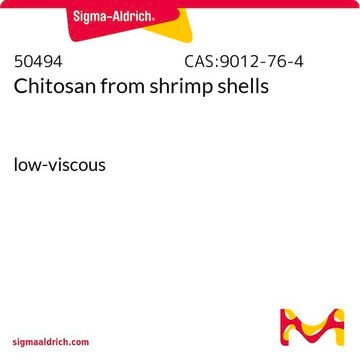The degree of acetylation should be above 75% for each lot, but the exact value will vary. For information on the degree of acetylation for a particular lot, contact the local technical service team.
Wichtige Dokumente
48165
Chitosan
highly viscous
Synonym(e):
2-Amino-2-deoxy-(1→4)-β-D-glucopyranan, Poly-(1,4-β-D-glucopyranosamin)
About This Item
Empfohlene Produkte
Biologische Quelle
(crab)
Form
powder
Verunreinigungen
≤1% insoluble matter
Glührückstand
≤2% (as SO4)
Verlust
≤12% loss on drying
Farbe
yellow
Viskosität
>400 mPa.s, 1 % in acetic acid(20 °C)
InChI
1S/C56H103N9O39/c1-87-56(86)65-28-38(84)46(19(10-74)96-55(28)104-45-18(9-73)95-49(27(64)37(45)83)97-39-12(3-67)88-47(85)20(57)31(39)77)103-54-26(63)36(82)44(17(8-72)94-54)102-53-25(62)35(81)43(16(7-71)93-53)101-52-24(61)34(80)42(15(6-70)92-52)100-51-23(60)33(79)41(14(5-69)91-51)99-50-22(59)32(78)40(13(4-68)90-50)98-48-21(58)30(76)29(75)11(2-66)89-48/h11-55,66-85H,2-10,57-64H2,1H3,(H,65,86)/t11-,12-,13-,14-,15-,16-,17-,18-,19-,20-,21-,22-,23-,24-,25-,26-,27-,28-,29-,30-,31-,32-,33-,34-,35-,36-,37-,38-,39-,40-,41-,42-,43-,44-,45-,46-,47-,48+,49+,50+,51+,52+,53+,54+,55+/m1/s1
InChIKey
FLASNYPZGWUPSU-SICDJOISSA-N
Suchen Sie nach ähnlichen Produkten? Aufrufen Leitfaden zum Produktvergleich
Allgemeine Beschreibung
Anwendung
Sonstige Hinweise
Lagerklassenschlüssel
11 - Combustible Solids
WGK
nwg
Flammpunkt (°F)
Not applicable
Flammpunkt (°C)
Not applicable
Persönliche Schutzausrüstung
Eyeshields, Gloves, type N95 (US)
Hier finden Sie alle aktuellen Versionen:
Besitzen Sie dieses Produkt bereits?
In der Dokumentenbibliothek finden Sie die Dokumentation zu den Produkten, die Sie kürzlich erworben haben.
-
What is the degree of deacetylation of this reagent?
1 answer-
Helpful?
-
-
What is the molecular weight of this chitosan (ref 48165)?
1 answer-
The molecular weight for this product is not analyzed on a lot to lot basis. However, the expected range is 500,000 to 700,000 g/mol.
Helpful?
-
-
Greetings I wish to know if this chitosan is soluble or insoluble in water. I also realized that there is water-soluble chitosan. Please kindly clarify the difference. I need them to do laboratory experiments.
1 answer-
This product has not been tested for it's solubility in water. However, one gram chitosan can be dissolved in a mixture of 100mL 10% acetic acid and 50mL methanol, and then precipitated from a precipitant consisted of 10mL ethanol and 90mL acetate ester. The treated chitosan should become soluble in acid-free water completely at 8.02mg/mL
Helpful?
-
Active Filters
Unser Team von Wissenschaftlern verfügt über Erfahrung in allen Forschungsbereichen einschließlich Life Science, Materialwissenschaften, chemischer Synthese, Chromatographie, Analytik und vielen mehr..
Setzen Sie sich mit dem technischen Dienst in Verbindung.



